Northants
News 18.2 Summer 2007
|
Mammillaria
(Cochemiea) setispina Ian Priestley |
(You can click the pictures in
these articles for a better view.)
Ed. I asked Ian if he would write
just a hundred words to go with his picture for the cover of the last edition.
You canít ask Ian to write only a hundred words on a plant he is
passionate about but read on...
|
I am one of those Luddites
that still call this a Cochemiea and not a Mammillaria, not through any
devotion to a botanical viewpoint, but because in marketing terms, it
continues and maintains the brand!
And what a brand it is! For
me, Cochemieas are the Rolls Royce of the cactus world. You can argue over
how many species there are, but C. setispina, along with C.
halei deserves a place in any cactophileís collection.
|
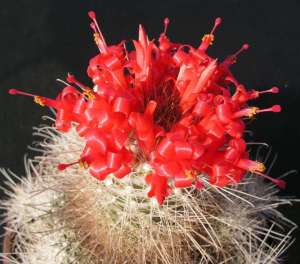
|
|
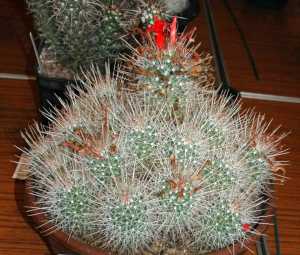
|
The editor has limited me
to 100 words, (actually 140!!) so all Iíll say is: look at Pilbeamís
Mammillarias if you want more details about the plant, its cultivation and
its history. But just look at the photographs to see the stunning contrast
between the gorgeous flower colours and the white spination, to see why
you should get one. Grow one, or even two!
Nuff said!!
Ian
Ed. We may
have taken the picture of Mammillaria setispina (above) from the front page
but now there is space for a pic of Ianís show plant (left) which won a first
at last yearís Mammillaria Show
|
The C word
Ian prefers the
name Cochemiea to Mammillaria. You can call your plants any name you like but
there are several reasons for not using Cochemiea. The most important is
that is difficult to spell. I have spent years training Mrs. Dell, the Wray
computer, (all computers are female), the names that are important and now I
have had to add yet another extinct name. Incidentally you did know that
Cochemiea was named after the Cochimi, an extinct tribe that lived in Baja years
ago. Years ago plants with that name were Mammillarias with red tubular flowers
that are pollinated by humming birds. Now we know that red tubular flowers are
just part of lifeís rich tapestry and they are all Mammillarias under the
skin. Nuff said!
Trev
|
The
creeping devil Mammillaria
Trevor
Wray |
|
When I read Ianís account
of what is arguably the best of the Mammillarias in the Cochemiea Section
I thought immediately of what is probably the worst. The picture on the
right shows Mammillaria poselgeri in habitat near La Paz in Baja
California. Unlike the real creeping devil, Machaerocereus eruca, this
one does not root as it creeps. Perhaps if it did it might look a little
better! Only the top two inches of every stem were worth looking at, the
next two feet were spineless and blotched red. Urgh! Admittedly, this was
a rather extreme specimen but wherever we saw it the stems were lying
along the ground and it looked very sorry for itself. |
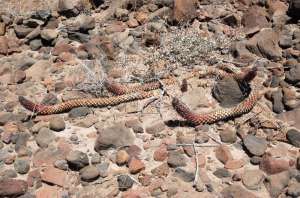
|
|
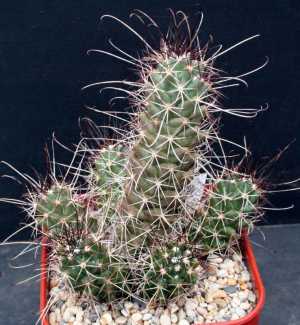
|
M. poselgeri
does
have a champion and I have added Vic Abellís picture (left) of a plant he is
cultivating. Vic tells me he is keeping the plant compact by growing it in full
sun. He is unlikely to be able to match the sunlight of the habitat and I would
like to see this plant in a few years. |
|
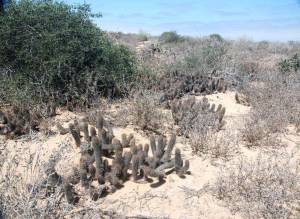
|
Mentioning the creeping
devil reminds me that while we were looking around one of its habitats we
came upon the other member of the Cochemiea Group that Ian likes,
Mammillaria halei.
This we are told occurs
only on Isla Magdalena but we saved ourselves the boat fare by finding an
escaped colony near the beach on the mainland. Since the plants surrounded
a small tree I can see a bird bringing the seeds over from the island and
planting them with a dollop of manure.
|
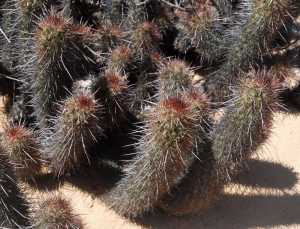
|
Now thatís two M word
articles in one edition of the mag. I must be mellowing!
Trev
|
More freshly gathered yarns from the world of seeds
Doug Rowland |
Doug brings us
the final instalment of snips from the world of seedÖ
41. The hardest and heaviest
seeds of 2005 are Entida gigas, the West Indian Sea Bean, so called
because itís frequently found washed up on western Scottish beaches, brought
over in the Gulf Stream. The 2005 seeds weigh 25 to 30 grams each. (Ed:
thatís about an ounce.) Last year from a different population they were
weighing in at 35 to 40 grams each. The trees live in secluded valleys in the
Dominican Republic and beans produced are 1.8 metres long. Seeds are like shiny
hard mahogany tablets, and scarification is difficult.
42. In 2004 in Denmark the most
popular species of seeds were Turbinicarpus boolianus followed by Euphorbia
bupleurifolia. In 2003 the scene was a little different, Lophophora
echinata topped the poll and its congener Lophophora frici was next
best.
43. Letter from a lady. ĎDear
Doug, Thank you for sending me your list, please find my order enclosed. For
replacement of out of stock items, please thrill meí.
44. In the American Southwest
around the Tucson area it is not very practical to use English summer bedding
plants in garden displays. They would need to be watered three or four times a
day, which is a bit impractical in a desert environment where water is precious.
So, around banks, shopping malls and car parks you will find beds and small
plots set out with larger succulents and an assortment of cacti. These include
Agave, Yucca and Dasylirion, a host of Opuntia bushes, Hesperaloe and
Ferocactus. The Opuntia flower in April and May followed by Saguaro and then
Ferocactus. Yucca spikes can be seen all summer. The days here in spring and
summer are a bit shorter than ours and it gets dark quickly. If there is no moon
and you are walking it is essential to look where you are going and not fall
onto anything.
45. In open grassy spaces in
central New Mexico, around Albuquerque and Belen can be found a small
ground-hugging spiny cactus, Corynopuntia clavata. This has 1Ē long egg
shaped joints, with sharp dagger-like spination. The species resembles a
Tephrocactus which it is not. It cultivates well and grows slowly, producing
yellow flowers and eventually very spiny yellow seed berries. With a little
difficulty and some care these can be removed from the plant with a pair of long
nosed pliers. After drying out, the spiny berries can with some difficulty be
opened and seeds removed. These will germinate erratically but somewhat more
readily than Tephrocactus. Ask Tony Parker who raised little plants from these
in the 1970ís
46. The seed cycle of the
Saguaro, Carnegiea gigantea is quite unique and in keeping with its environment.
This is a large and tall growing item which dominates much of the landscape in
suitable areas of central and south Arizona. There are colonies further south
too in Mexico, but these plants tend to be smaller in dimension due to the
warmer and drier climate there. This cactus proliferates around the Saguaro
National Monument south of Tucson. The clusters of white flowers of this giant
begin to open in the last days of April and well on into May in succession. At
this time a host of pollinators appear which includes bats, insects, small
mammals and birds. The seed berries grow on and eventually ripen at the end of
summer, and then split and open wide to reveal the seeds in a bright red pulp
looking from below like red flowers. These are raided by predators of all kinds
and eventually fall to the ground in autumn, quickly followed by the autumn
rains, which often cause flash floods with dried river beds being suddenly
filled with flood water. This washes the seeds all over the desert floor, where
they germinate in shade under stones, shrubs and bushes and in rock crevices in
shade. Seeds are always available and germinate well. Seedlings are rather slow
growing (a 1 metre plant is likely to be 30 years old). In habitat, most
Saguaros live for about 180 years and continue growing all of their life until
their large size causes them to be blown to the ground. These plants thrive best
in their range, plants I have seen at Prescott planted in a park, were too far
north of their habitat and were dying.
47. I am told by friends visiting
Sucre in Bolivia that in November 2004, seed collecting was not very successful.
Many plants were still in flower, and some had not been visited by pollinators.
The plants included Sulcorebutia, Lobivia and Parodia.
48. Most plants of Cactaceae
require to be pollinated by another of the same species of a different clone to
successfully complete fertilisation of the flowers. Cuttings taken from a parent
plant will always be the same clone although different plants in different pots.
A good plant to start pollination practice with is Rebutia, providing you have
two clones. Berries will be produced at ground level and eventually dry off and
split open. If you do not collect the seeds, they will be spread around the
plant base when watering and will germinate there.
49. Euphorbia seeds are never
very plentiful. This is because the capsules are tripartite and collecting seeds
from explosive capsules is time consuming and labour intensive. And of course,
male plants do not yield seeds. To collect seeds from exploding female plants of
Euphorbia obesa, lay muslin over the seeding area or place the whole plant in a
box with a clear plastic lid and wait for results.
50. Most Stapeliads, like Orchids
have a complicated pollination system. However, a few Stapelia with big smelly
five petalled flowers may well be visited by local blowflies in cultivation and
even have eggs in batches laid within the flower. With luck green seed horns
will be produced and gradually ripen a great number of windborne seeds complete
with parachute ready to float off into the blue. Collect the seeds up before
they disappear, and remove the parachute part. Most Stapeliads are of quick and
easy germination and grow on well, Hoodia and Trichocaulon doing well in a
warmer environment.
FOR A FINALE.
SEEDS FOR FREE AT THE SUPERMARKET
Last time we were in Arizona we
were staying near to the local supermarket. Outside in beds in the pavement were
three feet tall plants of Ferocactus acanthodes var. lecontei. Each day a few
more berries in rings around the top of the plant changed colour and ripened. We
occasionally took a few off, and opening with a penknife revealed 300 to 500 or
so dry ripe seeds. This is April. Plants begin flowering at the height of summer
and berries mature the following spring.
Doug






